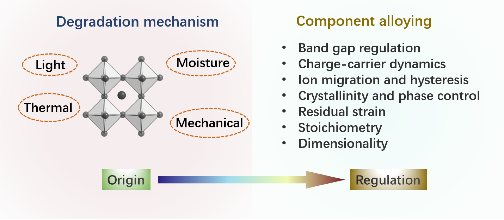Toward Stable Lead Halide Perovskite Solar Cells: A Knob on the A/X Sites Components
Shurong Wang, Aili Wang, Feng Hao*
School of Materials and Energy, University of Electronic Science and Technology of China, Chengdu, 611731, China
EXTENDED ABSTRACT: Hybrid lead halide ABX3 perovskite solar cells (PSCs) have emerged as a strong competitor to the traditional solar cells with a certified power conversion efficiency beyond 25%, and other remarkable features such as high optical absorption coefficients, long diffusion length up, low trap density, balanced ambipolar hole and electron transport, solution processability, and low manufacturing cost. Further development on the efficiency and stability brings forth increasing attention in the component regulation, such as partial or entire substitution of A/B/X sites by alternative elements with similar size. However, the relationships between composition-property-performance are poorly understood. Here, the instability of PSCs from the photon-, moisture-, thermal-, and mechanical-induced degradation was firstly summarized and discussed. In addition, the component regulation from the A/X sites are highlighted from the aspects of band level alignment, charge-carrier dynamics, ion migration, crystallization behavior, residual strain, stoichiometry, and dimensionality control.[1] Finally, the perspectives and future outlooks are highlighted to guide the rational design and practical application of PSCs.[2]

Figure 1. The degradation mechanism and regulation in mixed A/X alloys
REFERENCES
[1] S. Wang; J. Hu; A. Wang; Y. Cui; B. Chen; X. Niu and F. Hao, J. Energy Chem. 2022, 66, 422-428
[2] S. Wang; A. Wang; F. Hao, iScience, 2021, invited review.

Feng Hao received his PhD from Tsinghua University in 2012. Then he worked in the Department of chemistry, Northwestern University as a postdoc for four years. He is now a full professor at the School of Materials and Energy, University of Electronic Science and Technology of China. His research focuses on perovskite solar cells and photonic materials. He has published more than 90 SCI papers so far, with total citations over 6700 times.